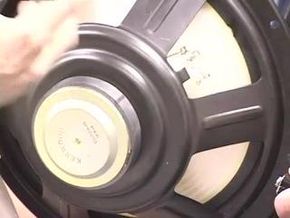Traditional speakers are able to produce sound by using an electromagnet to push and pull on a flexible cone. There are three basic types of driver that produce different types of sound: woofers, tweeters and midrange. Your ears ear different sounds depending on the size and frequency of the waves that reach your ears, which is where drivers come in. Traditional speakers use drivers to help translate electrical signals into physical vibrations so that you can hear recorded sounds.
The driver moves a flexible cone, or diaphragm, back and forth very quickly to produce these sound waves. The diaphragm is normally made of paper, plastic or metal and it's attached to the suspension's wide end and is occasionally more of a dome than a cone. The suspension, also called the surround, is a flexible metal rim that lets the cone move. It's connected to the basket, which is the driver's metal frame. On the narrow end of the cone is a voice coil, which hooks up to the basket via a flexible metal ring that lets the coil move back and forth while still keeping it in place.
Advertisement
The differences between woofers, tweeters and midrange drivers are mainly size-related. A woofer is the biggest type of driver, and it's meant to create low-frequency sounds. Meanwhile, tweeters are a lot smaller and they make the highest frequency sounds. Not surprisingly, midrange speakers cover the middle part of the spectrum between the woofers and the tweeters. The size dictates the frequency because to make higher frequency waves, the diaphragm has to vibrate faster. In a large cone, it's harder to get the diaphragm moving fast. By the same token, it would be too hard to get a small driver to vibrate at a slow enough rate to create the low-frequency sounds produced by a woofer.

